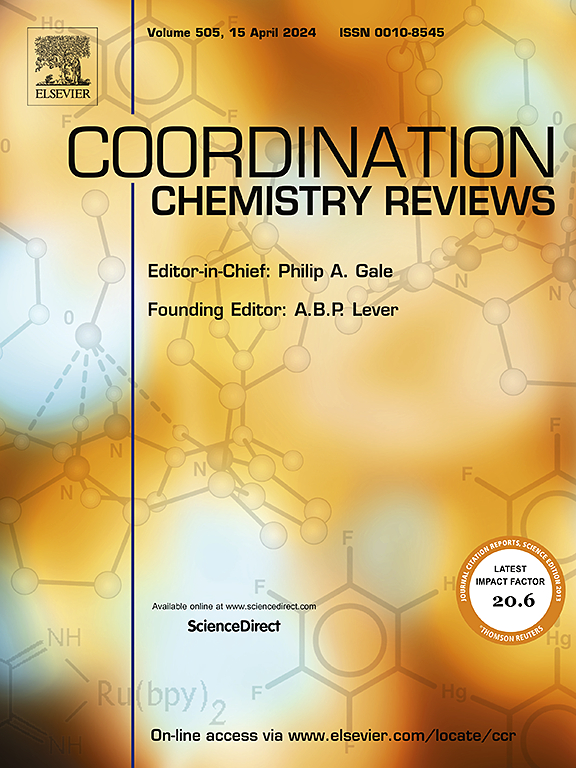Advances in crystallization chaperones based on a host-guest system for structural determination of difficult-to-crystallize molecules
IF 20.3
1区 化学
Q1 CHEMISTRY, INORGANIC & NUCLEAR
引用次数: 0
Abstract
Determining the precise atomic structure and absolute configuration of unknown compounds is a crucial goal in chemistry. Over the past few decades, several techniques for structural determination have been developed and refined, including nuclear magnetic resonance, mass spectrometry, infrared spectroscopy, and so on. However, these methods have limitations, particularly in the identification of complex structures, especially those with multiple chiral centers. Single crystal X-ray diffraction (SCXRD) is regarded as the most reliable technique for determining the absolute configuration of a compound. The primary prerequisite for the use of SCXRD is the successful cultivation of high-quality single crystals. Unfortunately, many organic molecules present significant challenges here, as growing suitable crystals can be a time-consuming and labor-intensive process, especially for compounds that are oily at room temperature or are inherently difficult to crystallize. This review will first examine traditional crystallization methods and the challenges they present. It will then shift focus on innovative crystallization strategies that exploit supramolecular host-guest interactions to determine the structures of various guest molecules. The host molecules discussed will include metal-organic frameworks, hydrogen-bonded organic frameworks, tetraaryladamantanes, macrocycles, and other novel crystalline chaperones with effective co-crystallization capabilities. Looking forward, this review highlights the potential of integrating artificial intelligence and machine learning to improve the efficiency and accuracy of single crystal growth and structural analysis. This review can serve as a valuable reference for the development and rational design of novel co-crystals.
基于主-客体体系的结晶伴侣在难结晶分子结构测定中的研究进展
确定未知化合物的精确原子结构和绝对构型是化学中的一个重要目标。在过去的几十年里,几种结构测定技术得到了发展和完善,包括核磁共振、质谱、红外光谱等。然而,这些方法有局限性,特别是在复杂结构的识别,特别是那些具有多个手性中心。单晶x射线衍射(SCXRD)被认为是确定化合物绝对构型最可靠的技术。使用SCXRD的首要前提是成功培养出高质量的单晶。不幸的是,许多有机分子在这里面临着巨大的挑战,因为生长合适的晶体可能是一个耗时和劳动密集型的过程,特别是对于在室温下油性或本质上难以结晶的化合物。本文将首先考察传统的结晶方法及其面临的挑战。然后,它将把重点转移到利用超分子主客体相互作用来确定各种客体分子结构的创新结晶策略上。讨论的宿主分子将包括金属有机框架、氢键有机框架、四芳基金刚烷、大环和其他具有有效共结晶能力的新型晶体伴侣分子。展望未来,本文强调了将人工智能和机器学习相结合以提高单晶生长和结构分析的效率和准确性的潜力。本文综述可为新型共晶的开发和合理设计提供有价值的参考。
本文章由计算机程序翻译,如有差异,请以英文原文为准。
求助全文
约1分钟内获得全文
求助全文
来源期刊

Coordination Chemistry Reviews
化学-无机化学与核化学
CiteScore
34.30
自引率
5.30%
发文量
457
审稿时长
54 days
期刊介绍:
Coordination Chemistry Reviews offers rapid publication of review articles on current and significant topics in coordination chemistry, encompassing organometallic, supramolecular, theoretical, and bioinorganic chemistry. It also covers catalysis, materials chemistry, and metal-organic frameworks from a coordination chemistry perspective. Reviews summarize recent developments or discuss specific techniques, welcoming contributions from both established and emerging researchers.
The journal releases special issues on timely subjects, including those featuring contributions from specific regions or conferences. Occasional full-length book articles are also featured. Additionally, special volumes cover annual reviews of main group chemistry, transition metal group chemistry, and organometallic chemistry. These comprehensive reviews are vital resources for those engaged in coordination chemistry, further establishing Coordination Chemistry Reviews as a hub for insightful surveys in inorganic and physical inorganic chemistry.
 求助内容:
求助内容: 应助结果提醒方式:
应助结果提醒方式:


